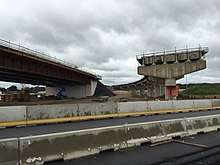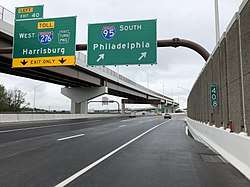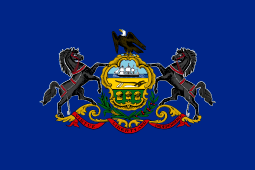Pennsylvania Turnpike/Interstate 95 Interchange Project
| Pennsylvania Turnpike/Interstate 95 Interchange Project | |
|---|---|
 Ramps for Interstate 95 under construction in 2017 | |
|
Currently built connection highlighted in red. Remaining proposed ramps shown in blue. | |
| Location | |
| Bristol Township, Bucks County, Pennsylvania | |
| Coordinates | 40°07′44″N 74°53′23″W / 40.128875°N 74.889727°WCoordinates: 40°07′44″N 74°53′23″W / 40.128875°N 74.889727°W |
| Roads at junction | |
| Construction | |
| Constructed | 2010–present |
| Opened | September 22, 2018[1] |
| Maintained by | Pennsylvania Turnpike Commission |
The Pennsylvania Turnpike/Interstate 95 Interchange Project is an ongoing road construction project to widen highways and build an interchange where Interstate 95 (I-95) crosses the Pennsylvania Turnpike in Bristol Township, Bucks County, Pennsylvania, in the United States. Construction began in November 2010, the interchange opened to the public on September 22, 2018,[1] and most of Phase I is expected be completed by 2020.[2] The first stage of the project is projected to cost about $553 million.[3]
The project fills the gap left on I-95 by the cancellation of the Somerset Freeway in New Jersey; widens the turnpike from U.S. Route 1 (US 1) eastward to the Delaware River–Turnpike Toll Bridge; and adds a second span to the bridge, which connects Bristol Township with Burlington Township, Burlington County, New Jersey. Ultimately, it extended Interstate 295 from its former northern terminus at US 1 west and south across the Scudder Falls Bridge along the former section of I-95 to the new interchange, and redirected I-95 eastward along the Pennsylvania Turnpike to the New Jersey Turnpike.
The project makes I-95 a continuous route between Philadelphia and New York City, at last completing the highway from Miami, Florida, to the Houlton–Woodstock Border Crossing in Maine. The project is the last in the country to be financed under the Federal-Aid Highway Act of 1956, which established the Interstate Highway System.[4] It is also the first transportation project in Pennsylvania to be funded through the EB-5 visa program; its success may lead the Pennsylvania Turnpike Commission to apply the program to the unfinished Mon–Fayette Expressway and Southern Beltway projects near Pittsburgh.[5]
History
At the formation of the Interstate Highway System, I-95 was planned as a Florida-to-Maine superhighway passing through the Northeast Megalopolis. However, decades of disputes among local and regional governments and private landowners prevented or delayed the design and construction of this highway from the Trenton–Philadelphia area to northern New Jersey in the New Brunswick–Piscataway area. Until 2018, I-95 was incomplete because of the gap in this area. If drivers wished to proceed northbound from Newark, Delaware, to New York City without encountering a traffic signal, the most direct route was (and still is today) to exit I-95 onto I-295 just south of Wilmington, enter New Jersey via the Delaware Memorial Bridge, and continue north on the New Jersey Turnpike. Alternatively, drivers who stayed on I-95 North passed through Delaware County, Pennsylvania, the city of Philadelphia, and Bucks County, Pennsylvania, and then over the Delaware River on the Scudder Falls Bridge into Mercer County, New Jersey, northwest of Trenton, where New Jersey now signs the freeway as I-295 South (with signs saying Formerly I-95 North). Before 2018, from this point, I-95 abruptly ended at the interchange of US 1 in Lawrence Township and became I-295 South. Motorists then entered I-195 eastbound from I-295 exit 60A, and then took I-195 to the New Jersey Turnpike northbound (where I-95 continues). According to the New Jersey Turnpike Authority, the turnpike was signed as I-95 in the area of Robbinsville Township north of Turnpike exit 7A (for I-195). However, NJDOT stated that I-95 started from the New Jersey – Pennsylvania Turnpike Connector Bridge and follows the New Jersey Turnpike Extension to the northbound lanes of the mainline of the turnpike.
Earliest designs
During the mid-1950s, while I-95 was still in its infancy, a proposal was made to route it through the city of Trenton by way of the Trenton Toll Bridge (now in use and designated to US 1).[6] New Jersey opposed this routing due to the limited capacity of that bridge. A proposal to bypass and loop around Trenton was formally proposed and agreed upon by both states in the late 1950s. What was eventually called the Scudder Falls Bridge was constructed in 1959. Completed soon afterward was a section of I-95 north of Trenton. Plans then began in the mid-1960s to join this segment to I-287 in northern New Jersey. This controversial section of I-95 became known as the Somerset Freeway, but by 1978, doubts were expressed that I-95 would ever be completed.[7]
Somerset Freeway
The Somerset Freeway was to run from existing I-95 in Hopewell Township northeast to I-287 in Piscataway Township, where I-95 would have followed I-287 east to the New Jersey Turnpike. The project was cancelled in 1982, primarily for two reasons. First, residents along the Princeton corridor feared increased congestion and a drop in property values. Second, the state of New Jersey feared a drop in state revenues by diverting traffic from the New Jersey Turnpike. A 1980 article in The New York Times stated:
Killing I-95 means that the entire length of the turnpike almost surely will become the official I-95 artery through the state, thus assuring it a continued source of toll revenue. At present, only that segment of the turnpike north of exit 10 in Middlesex County is designated as I-95.[8]
This did not come fully to pass, as the Commonwealth of Pennsylvania objected to having Interstate 95 removed from within its boundaries. Instead, I-95 was rerouted south on the New Jersey Turnpike to exit 6, and onto its Pennsylvania Extension to end at the state line, pending the construction of an interchange where the Pennsylvania Turnpike crossed existing I-95 in Pennsylvania. This route was legislated in the Surface Transportation Assistance Act of 1982.[9]
Finalization of plans
Although this project was legislated in 1982, an impact study was not started by the Pennsylvania Turnpike Commission until 1992, which was not completed until 2003. Details were hashed out during the design sessions that took place from 2004 to 2006. One of the last pieces of the puzzle was the question of what would become of the existing section of I-95 north of the interchange. The Design Advisory Committee determined that in order to avoid confusion, that segment would become an extension of I-195 when the interchange is completed,[10] and the part of I-276 east of the interchange would become part of I-95. On May 20, 2015, it was decided to extend I-295 instead of I-195 along the former I-95 into Pennsylvania south to the new interchange.[11]
Design and construction


The multi-phased construction began in late 2010, and the approved design calls for Phase I to tentatively end in late 2019.[12] Groundbreaking for the interchange took place on July 30, 2013, with Governor Tom Corbett in attendance.[13] Construction of the first stage of the interchange began in fall 2014.[14] The first two phases consist of the development of a single-loop interchange at the point where the Pennsylvania Turnpike (I-276) and I-95 meet in Bristol Township, although according to the official project website, the re-designation that officially bridges the I-95 gap was planned for September 22, 2018, before the completion of Phase I.[15] In March 2018, I-95 was renumbered to I-295 between US 1 in Lawrence Township, New Jersey and Taylorsville Road in Lower Makefield Township, Pennsylvania. In July 2018, I-295 was extended southward to the future Pennsylvania Turnpike intersection, switching cardinal directions at Taylorsville Road, with northbound becoming westbound.[16][17]
In order to accommodate the projected high traffic volume, a new tollbooth, completed in January, 2016, is approximately two miles (3.2 km) west of the interchange, terminating the toll ticket part of the turnpike system. The former tollbooth at the Delaware River bridge has been converted to an electronic toll gantry which collects a flat-rate toll for west- and southbound traffic only.[18] This phase also calls for the widening of the Turnpike between exits 351 (US 1) and 358 (US 13) from four lanes to six. The third and final phase will consist of the construction of a second bridge across the Delaware River, adjacent to the current one, that will allow east- and westbound traffic to utilize separate bridge spans. In this respect, the design is similar to that of the Delaware Memorial Bridge.
The first stage of the project, which includes the new toll plaza, widening, and the flyover ramps between I-95 and the turnpike, is projected to cost about $553 million.[3] The flyover ramps are expected to cost $142.9 million, with $100 million coming from federal funds and the remainder from the turnpike commission. The Pennsylvania Turnpike Commission is borrowing money from foreign investors in order to provide funding for the project. The remaining stages of the project are unfunded, with a projected total cost of $1.1 billion for the entire project.[14]
Cashless tolling
While the eastern terminus of the toll ticket system was moved from the Delaware River Bridge to a spot two miles (3.2 km) west of the interchange, the previous tollbooth at the bridge was replaced by a new cashless toll system—a first for Pennsylvania.[19] This toll system was instituted for westbound drivers only. Customers without EZ Pass will be able to pass through at normal highway speed. As they pass through the toll gantry, a camera takes a picture of the driver's license plate and the driver will be mailed an invoice for the toll. This new tolling system opened to traffic on January 3, 2016.
Route designation
Signage was changed for affected highways throughout 2018.[20]
| Highway section | Former designation | Current designation |
|---|---|---|
| I-95 from the PA Turnpike in Bristol Township to US 1 in Lawrence Township | I-95 | I-295 |
| PA Turnpike from the new interchange in Bristol Township to the Delaware River Turnpike Bridge | I-276 | I-95 |
| NJ Turnpike Pennsylvania Extension (Pearl Harbor Memorial Turnpike Extension) from the Delaware River Turnpike Bridge to the mainline NJ Turnpike | I-95 (unsigned) | I-95 |
| Mainline NJ Turnpike from the NJ Turnpike Pennsylvania Extension (Pearl Harbor Memorial Turnpike Extension) in Mansfield Township to I-195 in Robbinsville Township | I-95 (unsigned) | I-95 |
See also
- List of gaps in Interstate Highways
- Interchanges in Pennsylvania


References
- 1 2 Sofield, Tom (September 22, 2018). "Decades in the Making, I-95, Turnpike Connector Opens to Motorists". Levittown Now. Retrieved September 22, 2018.
- ↑ "FAQ". patpconstruction.com. The Pennsylvania Turnpike Commission. Retrieved 21 August 2018.
- 1 2 "Background - Construction Spending". www.patpconstruction.com. The Pennsylvania Turnpike Commission. Retrieved 21 August 2018.
- ↑ Staff. "Interstate Frequently Asked Questions". Federal Highway Administration. Retrieved February 25, 2008.
- ↑ Kerlik, Bobby (December 13, 2014). "Investors Eager to Trade Cash for Green Cards in Immigration Program". Pittsburgh Tribune-Review. Retrieved December 19, 2014.
- ↑ Anderson, Steve. "Interstate 95: New Jersey (Trenton Section)". Eastern Roads. Self-published. Retrieved February 1, 2012.
- ↑ Waldron, Martin (March 19, 1978). "Caution! Some Roads Lead Nowhere". The New York Times. p. E8.
- ↑ Sullivan, Ronald (May 4, 1980). "The Killing of I-95: Too Much Too Late". The New York Times. p. NJ22.
- ↑ United States Congress. "Public Law 97-424" (PDF). U.S. Government Publishing Office. Retrieved January 23, 2017.
Notwithstanding any other provision of law, the Secretary of Transportation is authorized and directed, pursuant to section 103 of such title, to designate as part of the Interstate Highway System the New Jersey Turnpike from exit 10 to the interchange with the Pennsylvania Turnpike and the Pennsylvania Turnpike from such interchange to and including the proposed interchange with Interstate Route 95 in Bucks County, Pennsylvania
- ↑ Staff (September 14, 2005). Pennsylvania Turnpike Commission I-95/I-276 Interchange Project Meeting Design Management Summary Draft: Design Advisory Committee Meeting #2 (PDF) (Report). Edwards and Kelsey. Retrieved February 1, 2012.
- ↑ Nadeau, Gregory G. (May 20, 2015). "FHWA to AASHTO I-95 Designation" (PDF) (Letter). Letter to Bud Wright. Washington, DC: Federal Highway Administration. Archived from the original (PDF) on June 9, 2015. Retrieved June 8, 2015.
- ↑ "FAQ". patpconstruction.com. The Pennsylvania Turnpike Commission. Retrieved 13 July 2017.
- ↑ Chang, David (July 30, 2013). "New Project Links Pa. Turnpike to I-95". Philadelphia, PA: WCAU-TV. Retrieved July 30, 2013.
- 1 2 Nussbaum, Paul (August 14, 2014). "Work to begin on connecting Pa. Turnpike and I-95". The Philadelphia Inquirer. Retrieved December 2, 2014.
- ↑ "PA Turnpike / I-95 Interchange Project". www.patpconstruction.com. The Pennsylvania Turnpike Commission. Archived from the original on 13 July 2017. Retrieved 13 July 2017.
- ↑ "Schedule". I95Link.com. Retrieved April 13, 2018.
- ↑ "EXPLAINER: Why parts of I-95 are becoming I-295". 6abc Philadelphia. June 14, 2018. Retrieved August 20, 2018.
- ↑ Pound, Michael (November 13, 2003). "Cranberry Connector now open for business". Beaver County Times.
- ↑ Staff. "The Pennsylvania Turnpike Commission will open a new cashless tolling point at the Delaware River Bridge in southeastern Pennsylvania in January 2016".
- ↑ Triana, Daniel (December 21, 2017). "I-95 to be redesignated as I-295 in Mercer County starting in 2018" (Press release). New Jersey Department of Transportation. Retrieved December 21, 2017.
External links
| Wikimedia Commons has media related to Pennsylvania Turnpike/Interstate 95 Interchange Project. |
